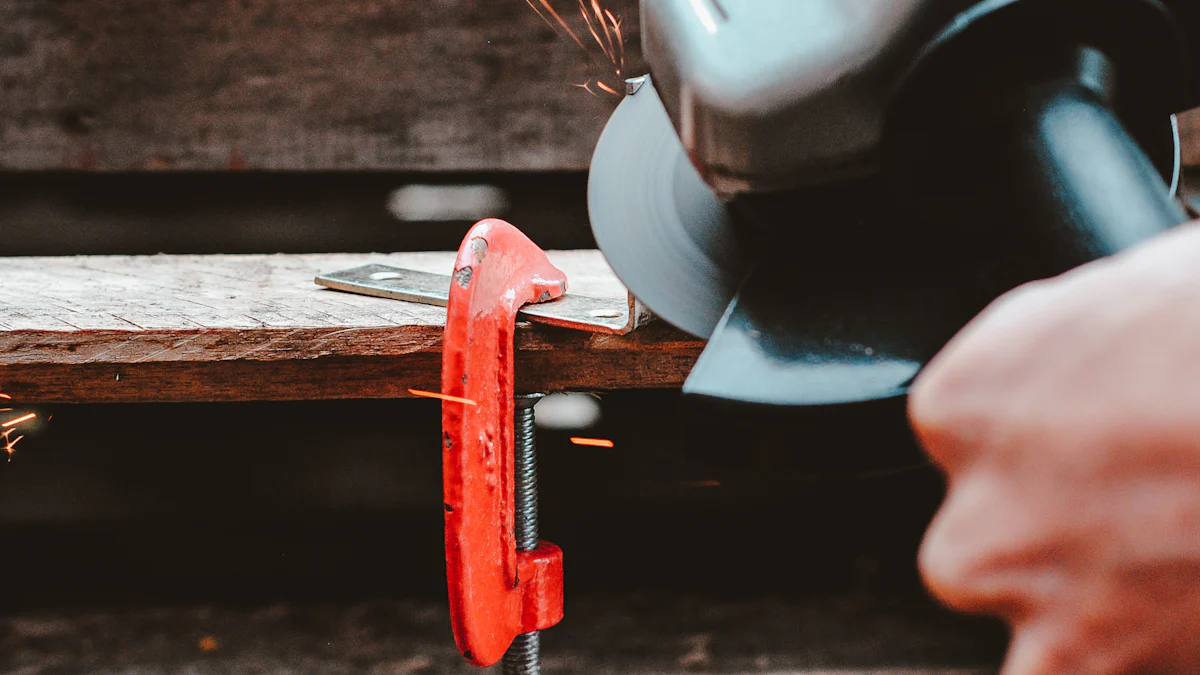 Using the right tools for cutting tin ensures both safety and precision. Various tin cutting tools, such as tin snips, aviation snips, nibblers, and electric shears, serve specific purposes. Each tool offers unique advantages tailored to different tasks. Safety remains paramount when handling sharp edges and blades. Wearing thick, cut-resistant gloves and safety glasses can prevent common injuries like lacerations and punctures. Proper tool selection and usage not only enhance efficiency but also minimize risks, making the process smoother and more effective.
Using the right tools for cutting tin ensures both safety and precision. Various tin cutting tools, such as tin snips, aviation snips, nibblers, and electric shears, serve specific purposes. Each tool offers unique advantages tailored to different tasks. Safety remains paramount when handling sharp edges and blades. Wearing thick, cut-resistant gloves and safety glasses can prevent common injuries like lacerations and punctures. Proper tool selection and usage not only enhance efficiency but also minimize risks, making the process smoother and more effective.
Understanding Tin Cutting Tools
Types of Tin Cutting Tools
Tin Snips
Tin snips are essential for cutting soft metals. These tools resemble scissors and provide precise control. Users can make straight cuts by stabilizing the tin with one hand and moving the snips forward with the other. Center snips excel at making straight cuts but cannot handle curves. For optimal performance, always use tin snips designed for the specific material thickness.
Aviation Snips
Aviation snips offer versatility for cutting both straight lines and curves. These snips come in three types: left-cutting, right-cutting, and straight-cutting. The compound action in the grips allows for cutting heavier materials without excessive force. Aviation snips are ideal for making tight curves and intricate shapes. Choose the appropriate type based on the direction of the cut and the material’s toughness.
Nibblers
Nibblers attach to electric drills and excel at cutting both straight lines and curves. These tools are particularly useful for cutting around obstacles like vent pipes. Stabilize the tin with one hand and guide the nibbler with the other. Nibblers provide clean cuts without distorting the metal, making them ideal for detailed work.
Electric Shears
Electric shears offer speed and efficiency for cutting large sheets of tin. These tools can handle both straight cuts and complex shapes. Electric shears reduce manual effort and increase productivity. Ensure that the shears are suitable for the material thickness to avoid damaging the tool or the workpiece.
Choosing the Right Tin Cutting Tool for the Job
Material Thickness
Selecting the appropriate tin cutting tool depends on the material thickness. Thin materials may only require tin snips, while thicker materials might need aviation snips or electric shears. Always check the manufacturer’s specifications to ensure the tool can handle the material’s thickness.
Type of Cut
The type of cut also influences the choice of tin cutting tool. Straight cuts are best achieved with center snips or electric shears. Curved cuts require aviation snips or nibblers. For intricate shapes and detailed work, nibblers provide the most precision.
Tool Features
Consider the features of each tin cutting tool. Look for ergonomic handles to reduce hand fatigue. Spring-loaded mechanisms can make repetitive cutting easier. Some tools offer replaceable blades, which extend the tool’s lifespan. Evaluate these features to select the most suitable tool for the task.
Preparing for Cutting
Safety Gear and Precautions
Gloves
Wearing gloves is essential when cutting tin. Thick, cut-resistant gloves protect hands from sharp edges and potential lacerations. Select gloves specifically designed for metalworking to ensure maximum protection. Always inspect gloves for any signs of wear or damage before starting the task.
Safety Glasses
Safety glasses shield eyes from flying metal fragments. Choose glasses with side shields for added protection. Ensure that the glasses meet industry standards for impact resistance. Regularly clean the lenses to maintain clear vision during cutting operations.
Protective Clothing
Protective clothing minimizes the risk of injury from sharp metal edges. Wear long sleeves and pants made from durable materials. Avoid loose-fitting clothes that could get caught in cutting tools. Consider using an apron or additional protective layers for extra safety.
Setting Up Your Workspace
Clear and Stable Surface
A clear and stable surface is crucial for effective tin cutting. Remove any clutter or obstacles from the workspace. Use a sturdy table or workbench to support the material being cut. Ensure that the surface is level to prevent the material from shifting during cutting.
Adequate Lighting
Proper lighting enhances visibility and precision. Use bright, focused lights to illuminate the cutting area. Position the lights to minimize shadows and glare. Good lighting helps in making accurate cuts and reduces the risk of errors.
Tool Accessibility
Keep all necessary tools within easy reach. Arrange tools in an organized manner on the workbench. Ensure that each tool is in good working condition before starting the task. Having tools readily accessible increases efficiency and reduces downtime.
Expert Testimony:
Expert, a specialist in Metal Cutting Safety, advises, “When in doubt, ask an expert for guidance on best practices to prevent harm.” This underscores the importance of proper preparation and adherence to safety protocols.
Cutting Techniques
Using Tin Snips
Straight Cuts
Tin snips excel at making straight cuts on soft metals. Users should stabilize the tin with one hand and move the snips forward with the other. This technique ensures a clean and precise cut. Always use tin snips designed for the specific material thickness to avoid damaging the tool or the workpiece.
Curved Cuts
Curved cuts require a different approach. Users should start by making small, incremental cuts along the desired curve. This method allows for better control and reduces the risk of distorting the metal. Aviation snips may also assist in making tighter curves.
Notching
Notching involves removing small sections of metal to create a specific shape. Users should make a series of small cuts to achieve the desired notch. This technique is useful for creating slots or tabs in the metal. Proper notching enhances the fit and finish of the final product.
Using Aviation Snips
Left-Cutting Snips
Left-cutting snips are ideal for making left-hand curves. Users should position the snips so that the waste material falls to the left. This positioning provides better visibility and control during the cut. Left-cutting snips are essential for intricate shapes and tight curves.
Right-Cutting Snips
Right-cutting snips perform best for right-hand curves. Users should position the snips so that the waste material falls to the right. This technique ensures a cleaner cut and reduces the risk of errors. Right-cutting snips are indispensable for detailed work.
Straight-Cutting Snips
Straight-cutting snips are designed for making long, straight cuts. Users should apply consistent pressure and maintain a steady hand. This method ensures a smooth and accurate cut. Straight-cutting snips are perfect for cutting large sheets of tin.
Using Nibblers and Electric Shears
Straight Cuts
Nibblers and electric shears excel at making straight cuts on large sheets of tin. Users should guide the tool along the desired line, applying steady pressure. This technique ensures a clean and precise cut without distorting the metal. Nibblers and electric shears increase productivity and reduce manual effort.
Complex Shapes
Complex shapes require careful planning and execution. Users should start by outlining the desired shape on the tin. Nibblers provide the flexibility to cut around obstacles and create intricate designs. Electric shears can handle more extensive cuts with ease. Both tools offer versatility and precision for detailed work.
Edge Finishing
Edge finishing involves smoothing and deburring the cut edges. Users should inspect the edges for burrs and rough spots. A file or deburring tool can remove any imperfections. Proper edge finishing enhances the safety and appearance of the final product.
Case Study:
Effective Metal Shearing Techniques Across Industries: Metal shearing techniques improve productivity, reduce material waste, and enhance product quality. These techniques demonstrate the versatility and innovation of metal shearing processes.
Post-Cutting Practices
Inspecting the Cut
Checking for Burrs
Inspect the cut edges for burrs. Burrs can cause injuries and affect the quality of the final product. Use a file or deburring tool to remove any sharp edges. Ensure that all burrs are eliminated before proceeding to the next step.
Ensuring Accuracy
Verify the accuracy of the cut. Measure the dimensions to confirm they match the specifications. Use a straightedge or square to check for straightness. Correct any deviations immediately to maintain precision in the project.
Tool Maintenance
Cleaning
Clean the tools after each use. Remove any metal shavings or debris from the blades and handles. Use a brush or compressed air for thorough cleaning. Proper cleaning prevents rust and prolongs the life of the tools.
Sharpening
Keep the cutting edges sharp. Dull blades can cause inaccurate cuts and require more force, increasing the risk of injury. Use a sharpening stone or specialized tool sharpener. Regular sharpening ensures efficient and clean cuts.
Proper Storage
Store the tools in a dry and secure location. Use protective covers for the blades to prevent damage. Organize the tools in a toolbox or on a pegboard for easy access. Proper storage maintains the tools’ condition and readiness for future use.
Testimonial:
“Safety gear may seem cumbersome, but an accident can lead to life-changing injuries. Make protective equipment a habit every time you work with metal cutting tools. Your health and safety should be the top priority in any workshop.”
Maintaining these post-cutting practices ensures safety and efficiency in metalworking projects. Proper inspection, maintenance, and storage of tools contribute to better performance and longevity. Always prioritize safety and precision in every step of the process.
Using a tin cutting tool safely and effectively requires attention to detail. Always select the appropriate tin cutting tool for the job. Wear protective gear like gloves and safety glasses. Maintain a clean and well-lit workspace. Regularly inspect and maintain each tin cutting tool to ensure optimal performance. Practice cutting techniques to improve skill and precision. Prioritize safety and accuracy in every task. Mastery of these practices will lead to successful and efficient tin cutting projects.
